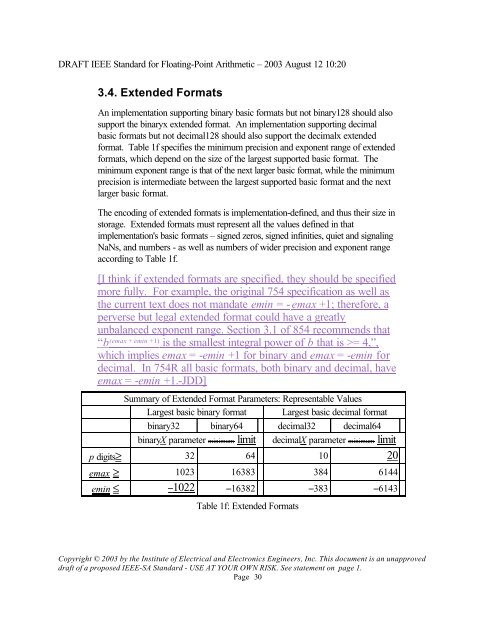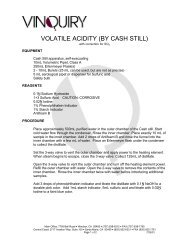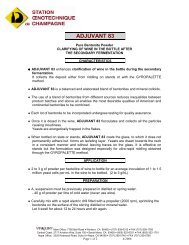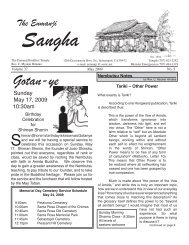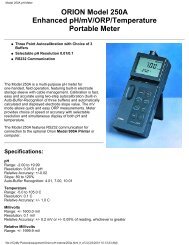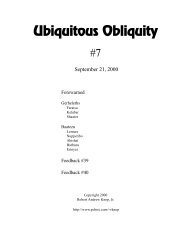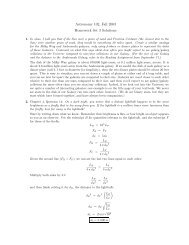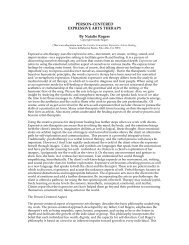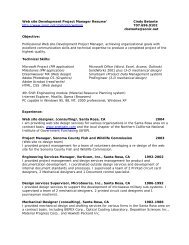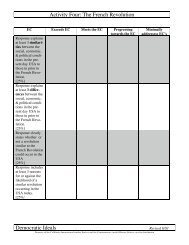DRAFT IEEE Standard for Binary Floating-Point Arithmetic - Sonic.net
DRAFT IEEE Standard for Binary Floating-Point Arithmetic - Sonic.net
DRAFT IEEE Standard for Binary Floating-Point Arithmetic - Sonic.net
Create successful ePaper yourself
Turn your PDF publications into a flip-book with our unique Google optimized e-Paper software.
<strong>DRAFT</strong> <strong>IEEE</strong> <strong>Standard</strong> <strong>for</strong> <strong>Floating</strong>-<strong>Point</strong> <strong>Arithmetic</strong> – 2003 August 12 10:20<br />
3.4. Extended Formats<br />
An implementation supporting binary basic <strong>for</strong>mats but not binary128 should also<br />
support the binaryx extended <strong>for</strong>mat. An implementation supporting decimal<br />
basic <strong>for</strong>mats but not decimal128 should also support the decimalx extended<br />
<strong>for</strong>mat. Table 1f specifies the minimum precision and exponent range of extended<br />
<strong>for</strong>mats, which depend on the size of the largest supported basic <strong>for</strong>mat. The<br />
minimum exponent range is that of the next larger basic <strong>for</strong>mat, while the minimum<br />
precision is intermediate between the largest supported basic <strong>for</strong>mat and the next<br />
larger basic <strong>for</strong>mat.<br />
The encoding of extended <strong>for</strong>mats is implementation-defined, and thus their size in<br />
storage. Extended <strong>for</strong>mats must represent all the values defined in that<br />
implementation's basic <strong>for</strong>mats – signed zeros, signed infinities, quiet and signaling<br />
NaNs, and numbers - as well as numbers of wider precision and exponent range<br />
according to Table 1f.<br />
[I think if extended <strong>for</strong>mats are specified, they should be specified<br />
more fully. For example, the original 754 specification as well as<br />
the current text does not mandate emin = - emax +1; there<strong>for</strong>e, a<br />
perverse but legal extended <strong>for</strong>mat could have a greatly<br />
unbalanced exponent range. Section 3.1 of 854 recommends that<br />
“ b (emax + emin +1) is the smallest integral power of b that is >= 4,”,<br />
which implies emax = -emin +1 <strong>for</strong> binary and emax = -emin <strong>for</strong><br />
decimal. In 754R all basic <strong>for</strong>mats, both binary and decimal, have<br />
emax = -emin +1.-JDD]<br />
Summary of Extended Format Parameters: Representable Values<br />
Largest basic binary <strong>for</strong>mat Largest basic decimal <strong>for</strong>mat<br />
binary32 binary64 decimal32 decimal64<br />
binaryX parameter minimum limit decimalX parameter minimum limit<br />
p digits≥ 32 64 10 20<br />
emax ≥ 1023 16383 384 6144<br />
emin ≤ –1022 –16382 –383 –6143<br />
Table 1f: Extended Formats<br />
Copyright © 2003 by the Institute of Electrical and Electronics Engineers, Inc. This document is an unapproved<br />
draft of a proposed <strong>IEEE</strong>-SA <strong>Standard</strong> - USE AT YOUR OWN RISK. See statement on page 1.<br />
Page 30


